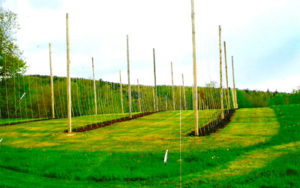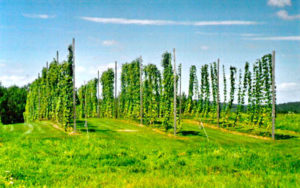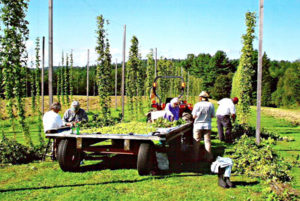 |
| Hops are supported by baling twine attached to aircraft cable running between 16-foot-tall posts. Photo courtesy of Richard Jones. |
By Holli Cederholm
Situated on adjacent parcels of land in Monroe, Maine, are three certified organic hops-growing operations owned by three friends who met in Florida. Richard Jones, a full-time boat captain and owner of Irish Hill Hops, was first to purchase land in Monroe in 1999. Arthur Lewis, a Florida chef and owner of Elm Hill Farm, and Ken Tassin, a Louisiana-based skipper and owner of Marsh Stream Hops, followed shortly after.
Together the trio owns 65 acres of land that was, for the most part, hayfield upon their acquisition. “We goofed around for a few years determining what to do with the fields rather than getting them hayed every year,” said Jones. The group wasn’t interested in raising mixed vegetables or livestock like so many other farms in the area. Lewis turned to history and learned that Maine had a hops cash crop in the 1800s, before the industry relocated to the drier West Coast. He proposed the crop to the group, and all three went to tour a small hops operation in Paris, Maine. “We decided to go into hops right there,” said Jones.
They contacted roughly 30 Maine microbreweries to see which varieties of hops they used in their craft brews. This information helped them select ‘Golding,’ ‘Sterling’ and ‘Cascade’ (the latter accounting for about 60 percent of their total crop).
 |
| Hops bines growing up trellises. Photo courtesy of Richard Jones. |
The Hops Crop
They next identified hardy sources of planting stock, from growers in New York, Washington and Oregon, and planted in the spring of 2008. Pre-planting preparation included tilling strips of soil in well-drained, sunny locations and creating a sufficient trellis system. Hops “bines” grow vertically (up to 25 feet in one season) and produce lateral side-arms, requiring top support and a system that trains the lateral arms for upward growth – like many trellises for indeterminate tomatoes.
Each farm uses the same spacing: 200-foot rows with 18 feet between rows. Every 25 feet within rows are 16-foot tall posts. The growers refer to each section between posts as a “bay.” Each bay holds 10 plants, and each grower tends about 300 plants. The plants are supported by aircraft cable running across the top of the posts and at the base. Individual bines are supported by baling twine, which is restrung each spring, running vertically between the cables.
“They come out of the ground in the spring; by August they’re up 16 feet in the air. You can damn near watch them grow,” said Jones. He explains that the rhizomes that they initially purchased were “little sticks about the size of a pencil… once it’s established though, the root system is just incredible.”
After bines emerge in the spring, each grower selects the three biggest shoots for each plant and prunes the rest. During the season they train the bines onto the baling twine trellis, weed and water – this last task is accomplished with a shared-use 300-gallon poly water tank pulled by a tractor and pumped by hand. They also watch for Japanese beetles and downy mildew, two of the biggest threats to hops.
 |
| Harvesting hops by hand in late summer. Photo courtesy of Richard Jones. |
In mid- to late August, when the papery hops “cones” are filled with yellow powder, the growers send samples of each variety to a hops laboratory in Oregon to test for alpha acids. This “alpha count” quantifies the hops’ characteristic bitterness. “Brewers want to know what the alpha is,” said Jones. Ultimately, this determines whether or not it’s harvest time.
After testing, the three growers, accompanied by friends and neighbors, cut entire vines and start hand-picking the hops cones for market. They hope to accomplish the entire harvest within two weeks. “A person can only maybe pick a bushel and a half a day,” Jones said. “It’s pretty labor intensive.”
Maine-based Marketing
Hops aren’t supposed to yield much until their third growing season, which for the Monroe growers was 2010. They did however harvest and market a small crop during 2009, despite the wet weather. Currently they sell their harvested cones to three Maine microbreweries: Allagash Brewing Company, Black Bear Brewery and Sebago Brewing Company. Sebago buys the majority of their ‘Cascade’ cones and is the only company to offer a beer, the seasonal Local Harvest Ale, made entirely from Monroe hops partnered with Aroostook-grown barley.
Jones, Lewis and Tassin are still looking for a market for their lesser-known ‘Golding’ and ‘Sterling’ hops, which Jones hopes Sebago will purchase in the future. Sebago’s owner was excited about the project and forged a positive business relationship with the growers from the start. “He even buys vines from us to use as decorations,” said Jones, who also appreciates that Sebago will purchase the hops wet, or fresh, whereas other brewing companies prefer dried cones.
“A bushel basket only weighs 10 pounds… that’s wet,” said Jones. Selling hops fresh also reduces handling and packaging time for the growers. They simply pack wet hops into big burlap bags, which allow the crop to breathe during transport.
Yet most brewers are accustomed to buying dry cones. To dry hops, the growers spread the cones on hardware cloth trays situated in homemade boxes with fans. “They end up popping around like popcorn,” said Jones. Marketing dried hops also requires vacuum-sealed packaging and freezing until delivery.
For Jones, Lewis and Tassin, hops are a “boutique crop,” i.e., hops sales do not account for their entire annual incomes. “If we could grow about 1,000 pounds a year, we’d be doing pretty good,” said Jones. The growers are also still waiting for their investment in organic certification to pay off. (They would have practiced organic management regardless.) The market for local hops, especially for popular varieties such as ‘Cascade,’ is there – but they’re uncertain as to whether certified organic makes a difference. “Very few beers out there are actually organic,” said Jones, so brewing companies aren’t demanding organic hops and aren’t paying the premium price the growers had hoped for.

